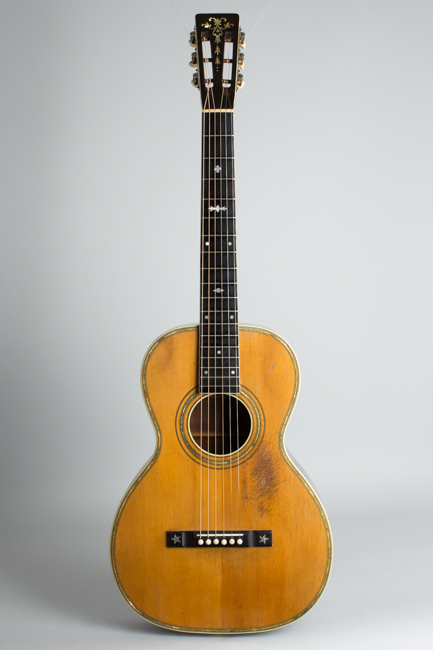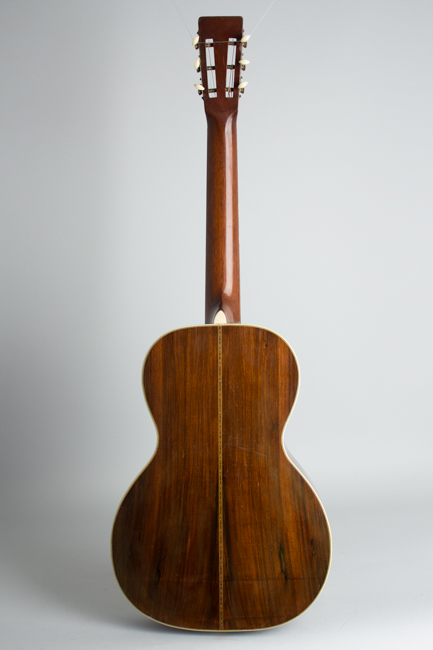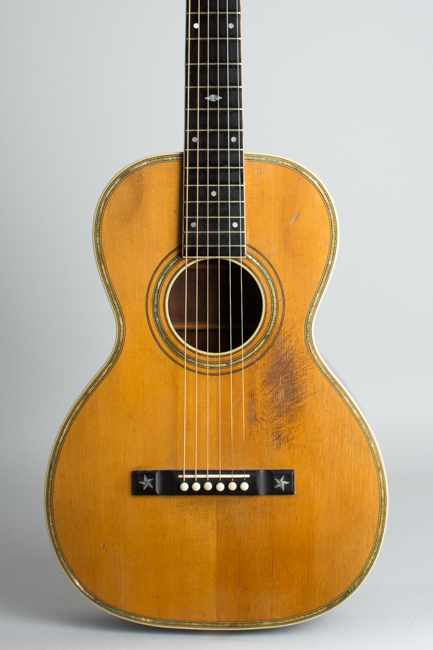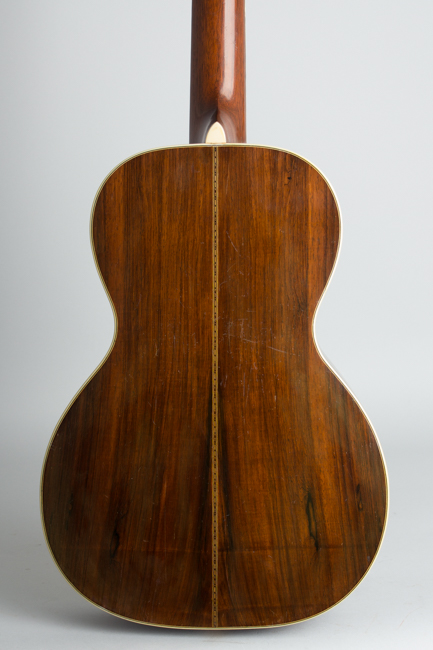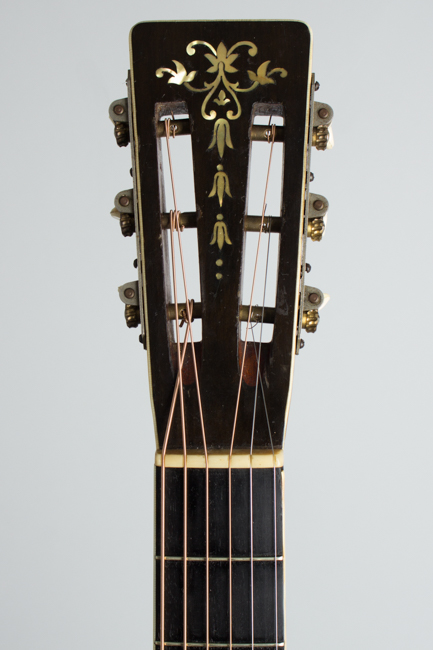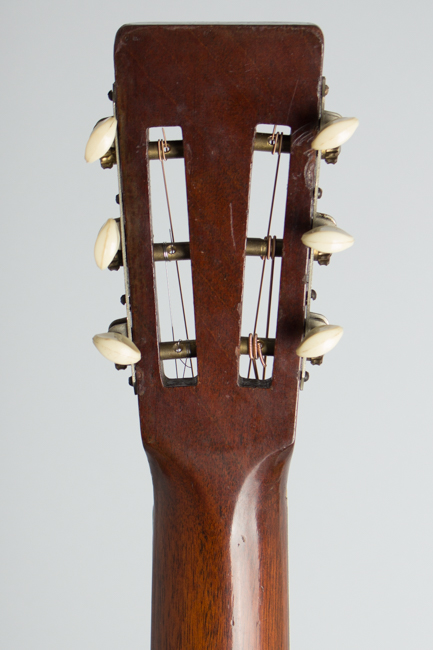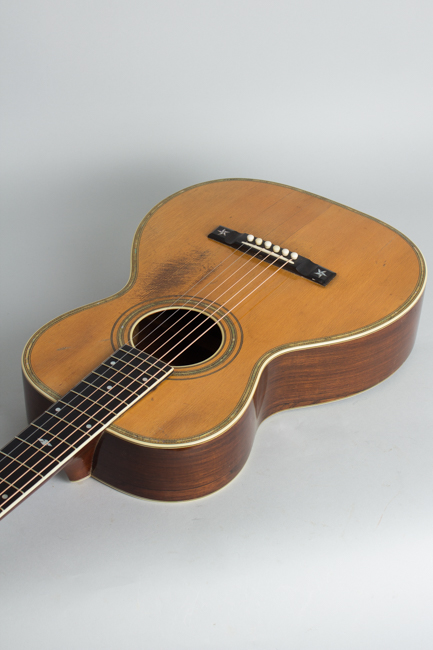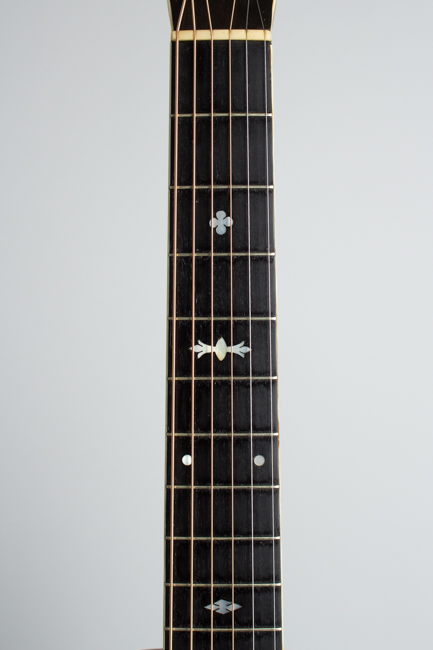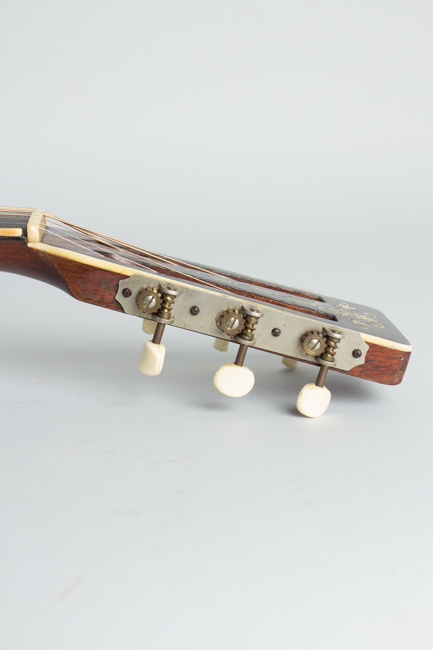Wm. Stahl Solo Style # 8 Flat Top Acoustic Guitar, made by Larson Brothers , c. 1926
This item has been sold.
Item # 8347
Prices subject to change without notice.
Wm. Stahl Solo Style # 8 Model Flat Top Acoustic Guitar, made by Larson Brothers, c. 1926, made in Chicago, serial # 32540, natural varnish finish, Brazilian rosewood back and sides, spruce top; mahogany neck with ebony fingerboard, black hard shell case.
Any discussion of the finest flat-top guitars ever made will soon enough come around to the work of Carl and August Larson. From the very beginning of the 20th century up until WWII, the Larsons' small Chicago workshop turned out a dizzying assortment of exceptionally well-crafted fretted instruments -- guitars, mandolins, the occasional ukulele, and even harp guitars. The catch is, the Larsons never put their own name on their instruments. Much of their output was contracted to sell under other brands, with guitars labeled "Maurer" sold by themselves. When building instruments to order, the Larsons made what was requested, but always to their own lofty standards.
One of their most prominent resale accounts was William C. Stahl of Milwaukee, a virtuoso mandolin player who had turned to authoring instruction methods. Around 1906 the Larsons began supplying mandolins and guitars to Stahl, who claimed himself as the maker, a deception common in this "patent medicine" era. Wm. C. Stahl remained one of the Larson's biggest accounts in the 'aught years and 'teens, and they built a steady stream of mandolins and some guitars for him up into the 1930s. If Carl and August seemed reticent to promote themselves, William Stahl was the opposite: garrulous, confident, and endlessly chatty.
Stahl's 1910s ads scoff at "machine-made" instruments, insisting his are strictly "handmade ... reasonable in price and perfect as human hands can make them" and built under his "personal supervision". This would have been quite a trick, as the Larsons were building in Chicago while Stahl's offices were in Milwaukee! While Stahl primarily promoted mandolins, he also sold a decent proportion of guitars, including high-end pieces like this one.
This particular instrument is a very fine example of the brothers' finest work, labeled for Willian Stahl but in every way a Larson product. The brothers' instruments have become recognized as uniquely desirable and historically important in recent years, and the best grade flat-top guitars are the most sought-after pieces. This model appears to be a Stahl "Artist Special" #8, although it may actually be a #7; the catalogs are often not representative of the actual instruments and the differences in these two models as cataloged in the 1910s are minor.
Whatever its actual designation this is a beautiful guitar featuring many of the Larson brother's higher grade appointments. The back and sides are high-grade Brazilian rosewood with a lovely grain figure. The top is very tight-grained spruce, built with the Larson Brothers' patented laminated X-brace system-the patent date for this innovation is stamped under the top near the bridge. This is a special feature of this particular guitar as it was often not used on Stahl-brand instruments, many of which have standard non-laminated spruce braces.
The top edge is bordered with a wide beveled celluloid strip, two half-herringbone bands, and gleaming abalone inlay around the circumference and the sound hole rim. The bridge is ebony with an engraved pearl star inlaid on each end. The neck is one piece of mahogany and features a rounder profile than most period necks, giving a surprisingly modern feel on a nearly century-old guitar. The very thick ebony fingerboard is bound with grained ivoroid and inlaid with shaped pearl pieces. The headstock is overlaid with Brazilian rosewood, bound and inlaid with a delicate pearl floral pattern running down the face. This is a truly fine representation of the Larson's artistry, well played but still and exceptional instrument.
Overall length is 38 1/4 in. (97.2 cm.), 13 1/2 in. (34.3 cm.) wide at lower bout, and 3 3/8 in. (8.6 cm.) in depth at side, taken at the end block. Scale length is 24 3/4 in. (629 mm.). Width of nut is 1 7/8 in. (48 mm.). This guitar is in excellent playing condition but does show wear and some well-executed repairs. The top had several cracks behind the bridge and one off the treble waist, all neatly sealed up but still visible. There are also several back cracks, also well repaired. The finish in these repair spots appears polished out but not oversprayed. The top has a number of dings and scrapes, a few are fairly deep. There is a decent sized area of wear from fingers below the soundhole into the top wood.
Internally the unique bracing is all original but the bridgeplate looks to have been replaced some time ago; it is slightly larger than the original but still not overly thick. There is an older two-point contact pickup currently mounted rigged to an endpin jack. The neck has been reset but both bridge and frets remain original, and the guitar plays very well. The tuners are 1940's or '50's era Kluson strips and have probably been there for a long time. This is a lovely sounding guitar, a testament to the Larson's talents and a relative bargain in a wonderful early-20th century X-braced, Brazilian rosewood instrument. It is housed in a very interesting though not original period HSC that may have been originally intender for a Weissenborn. Excellent - Condition.
Any discussion of the finest flat-top guitars ever made will soon enough come around to the work of Carl and August Larson. From the very beginning of the 20th century up until WWII, the Larsons' small Chicago workshop turned out a dizzying assortment of exceptionally well-crafted fretted instruments -- guitars, mandolins, the occasional ukulele, and even harp guitars. The catch is, the Larsons never put their own name on their instruments. Much of their output was contracted to sell under other brands, with guitars labeled "Maurer" sold by themselves. When building instruments to order, the Larsons made what was requested, but always to their own lofty standards.
One of their most prominent resale accounts was William C. Stahl of Milwaukee, a virtuoso mandolin player who had turned to authoring instruction methods. Around 1906 the Larsons began supplying mandolins and guitars to Stahl, who claimed himself as the maker, a deception common in this "patent medicine" era. Wm. C. Stahl remained one of the Larson's biggest accounts in the 'aught years and 'teens, and they built a steady stream of mandolins and some guitars for him up into the 1930s. If Carl and August seemed reticent to promote themselves, William Stahl was the opposite: garrulous, confident, and endlessly chatty.
Stahl's 1910s ads scoff at "machine-made" instruments, insisting his are strictly "handmade ... reasonable in price and perfect as human hands can make them" and built under his "personal supervision". This would have been quite a trick, as the Larsons were building in Chicago while Stahl's offices were in Milwaukee! While Stahl primarily promoted mandolins, he also sold a decent proportion of guitars, including high-end pieces like this one.
This particular instrument is a very fine example of the brothers' finest work, labeled for Willian Stahl but in every way a Larson product. The brothers' instruments have become recognized as uniquely desirable and historically important in recent years, and the best grade flat-top guitars are the most sought-after pieces. This model appears to be a Stahl "Artist Special" #8, although it may actually be a #7; the catalogs are often not representative of the actual instruments and the differences in these two models as cataloged in the 1910s are minor.
Whatever its actual designation this is a beautiful guitar featuring many of the Larson brother's higher grade appointments. The back and sides are high-grade Brazilian rosewood with a lovely grain figure. The top is very tight-grained spruce, built with the Larson Brothers' patented laminated X-brace system-the patent date for this innovation is stamped under the top near the bridge. This is a special feature of this particular guitar as it was often not used on Stahl-brand instruments, many of which have standard non-laminated spruce braces.
The top edge is bordered with a wide beveled celluloid strip, two half-herringbone bands, and gleaming abalone inlay around the circumference and the sound hole rim. The bridge is ebony with an engraved pearl star inlaid on each end. The neck is one piece of mahogany and features a rounder profile than most period necks, giving a surprisingly modern feel on a nearly century-old guitar. The very thick ebony fingerboard is bound with grained ivoroid and inlaid with shaped pearl pieces. The headstock is overlaid with Brazilian rosewood, bound and inlaid with a delicate pearl floral pattern running down the face. This is a truly fine representation of the Larson's artistry, well played but still and exceptional instrument.
Overall length is 38 1/4 in. (97.2 cm.), 13 1/2 in. (34.3 cm.) wide at lower bout, and 3 3/8 in. (8.6 cm.) in depth at side, taken at the end block. Scale length is 24 3/4 in. (629 mm.). Width of nut is 1 7/8 in. (48 mm.). This guitar is in excellent playing condition but does show wear and some well-executed repairs. The top had several cracks behind the bridge and one off the treble waist, all neatly sealed up but still visible. There are also several back cracks, also well repaired. The finish in these repair spots appears polished out but not oversprayed. The top has a number of dings and scrapes, a few are fairly deep. There is a decent sized area of wear from fingers below the soundhole into the top wood.
Internally the unique bracing is all original but the bridgeplate looks to have been replaced some time ago; it is slightly larger than the original but still not overly thick. There is an older two-point contact pickup currently mounted rigged to an endpin jack. The neck has been reset but both bridge and frets remain original, and the guitar plays very well. The tuners are 1940's or '50's era Kluson strips and have probably been there for a long time. This is a lovely sounding guitar, a testament to the Larson's talents and a relative bargain in a wonderful early-20th century X-braced, Brazilian rosewood instrument. It is housed in a very interesting though not original period HSC that may have been originally intender for a Weissenborn. Excellent - Condition.
